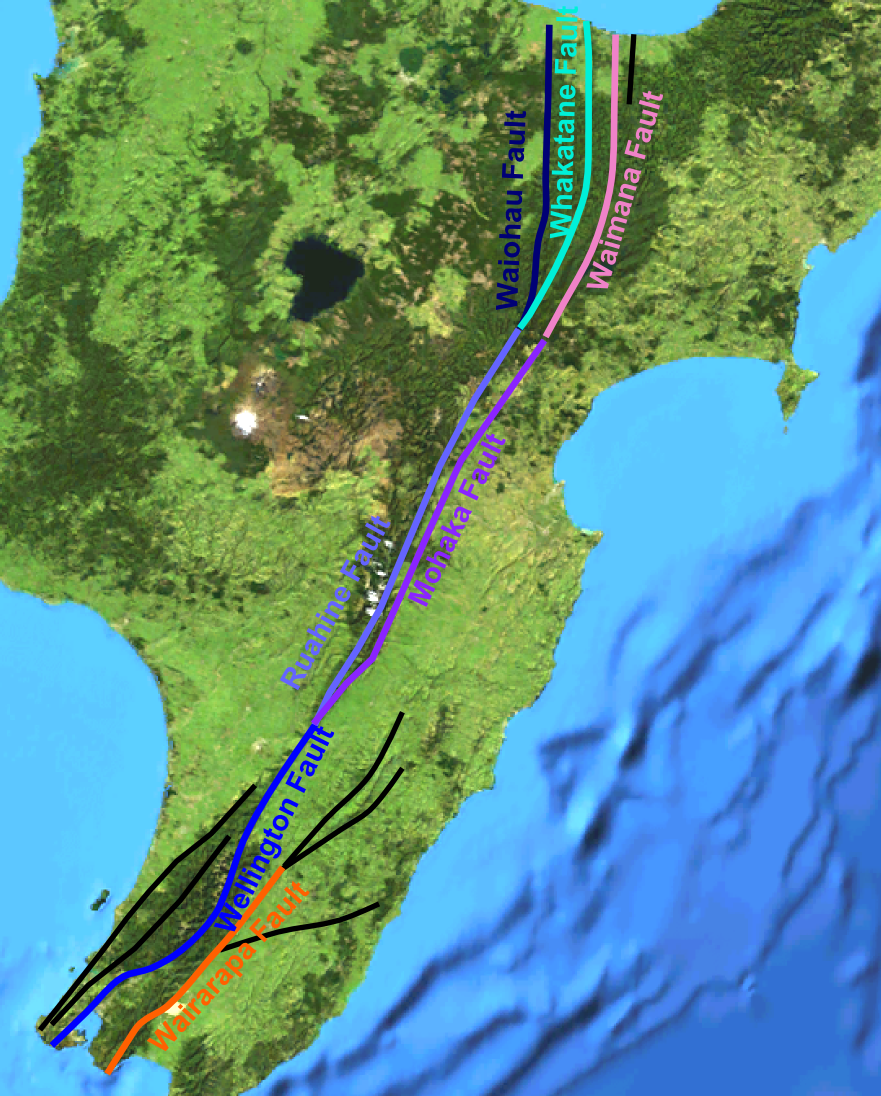|
Mangahao River
The Mangahao River is located in the North Island of New Zealand. The headwaters are in the Tararua Ranges. The river flows northeast feeds into the Manawatu River south of Woodville. There are two dams on the river which tunnel water, via a third reservoir on the Tokomaru River, to the Mangahao Power Station located on the Mangaore Stream near Shannon. Geology Within the last 10,000 years the upper of the river has been captured at Kakariki from the Hukanui Stream, which feeds the Mangatainoka River. The crush zone of the Wellington Fault probably assisted the capture. The capture has deepened the gorge cut into the Mesozoic greywacke and argillite :''"Argillite" may also refer to Argillite, Kentucky.'' Argillite () is a fine-grained sedimentary rock composed predominantly of indurated clay particles. Argillaceous rocks are basically lithified muds and oozes. They contain variable amounts ... of the Tararuas, which in places is over deep. References Rivers ... [...More Info...] [...Related Items...] OR: [Wikipedia] [Google] [Baidu] |
Tararua Range
The Tararua Range, often referred to as the Tararua Ranges or Tararua, is one of several mountain ranges in the North Island of New Zealand. The Tararua Range runs northeast–southwest for from near Palmerston North to the upper reaches of the Hutt Valley, where the northern tip of the Remutaka Range begins. It is separated in the north from the southern end of the Ruahine Range by the Manawatu Gorge. Most of the Range is wilderness, protected as the Tararua Forest Park. The highest peak in the Tararua Range is Pukeamoamo / Mitre (not to be confused with Mitre Peak) at . Other prominent peaks include Mount Bannister at and Mount Hector at , which is named after the scientist Sir James Hector. Its Māori name is Pukemoumou, or 'hill of desolation'. Geography The Tararua Range is divided into two distinct northern and southern regions. Each of these is dominated by a central mountain peak: Arete in the north and Hector in the south. A total of ten rivers rise on the ... [...More Info...] [...Related Items...] OR: [Wikipedia] [Google] [Baidu] |
Stream Capture
Stream capture, river capture, river piracy or stream piracy is a geomorphological phenomenon occurring when a stream or river drainage system or watershed is diverted from its own bed, and flows instead down the bed of a neighbouring stream. This can happen for several reasons, including: *Tectonic earth movements, where the slope of the land changes, and the stream is tipped out of its former course *Natural damming, such as by a landslide or ice sheet *Erosion, either **Headward erosion of one stream valley upwards into another, or **Lateral erosion of a meander through the higher ground dividing the adjacent streams. **Within an area of karst topography, where streams may ''sink'', or flow underground (a sinking or losing stream) and then reappear in a nearby stream valley *Glacier retreat The additional water flowing down the capturing stream may accelerate erosion and encourage the development of a canyon (gorge). The now-dry valley of the original stream is known as a ... [...More Info...] [...Related Items...] OR: [Wikipedia] [Google] [Baidu] |
Argillite
:''"Argillite" may also refer to Argillite, Kentucky.'' Argillite () is a fine-grained sedimentary rock composed predominantly of indurated clay particles. Argillaceous rocks are basically lithified muds and oozes. They contain variable amounts of silt-sized particles. The argillites grade into shale when the fissile layering typical of shale is developed. Another name for poorly lithified argillites is ''mudstone''. These rocks, although variable in composition, are typically high in aluminium and silica with variable alkali and alkaline earth cations. The term ''pelitic'' or ''pelite'' is often applied to these sediments and rocks. Metamorphism of argillites produces slate, phyllite, and pelitic schist. Belt Supergroup The Belt Supergroup, an assemblage of rocks of late Precambrian (Mesoproterozoic) age, includes thick sequences of argillite, as well as other metamorphosed or semi-metamorphosed mudstones.Schieber, J. 1990. Significance of styles of epicontinental shale sedime ... [...More Info...] [...Related Items...] OR: [Wikipedia] [Google] [Baidu] |
Greywacke
Greywacke or graywacke (German ''grauwacke'', signifying a grey, earthy rock) is a variety of sandstone generally characterized by its hardness, dark color, and poorly sorted angular grains of quartz, feldspar, and small rock fragments or lithic fragments set in a compact, clay-fine matrix. It is a texturally immature sedimentary rock generally found in Paleozoic strata. The larger grains can be sand- to gravel-sized, and matrix materials generally constitute more than 15% of the rock by volume. The term "greywacke" can be confusing, since it can refer to either the immature (rock fragment) aspect of the rock or its fine-grained (clay) component. The origin of greywacke was unknown until turbidity currents and turbidites were understood, since, according to the normal laws of sedimentation, gravel, sand and mud should not be laid down together. Geologists now attribute its formation to submarine avalanches or strong turbidity currents. These actions churn sediment and cause mi ... [...More Info...] [...Related Items...] OR: [Wikipedia] [Google] [Baidu] |
Mesozoic
The Mesozoic Era ( ), also called the Age of Reptiles, the Age of Conifers, and colloquially as the Age of the Dinosaurs is the second-to-last era of Earth's geological history, lasting from about , comprising the Triassic, Jurassic and Cretaceous Period (geology), Periods. It is characterized by the dominance of archosaurian reptiles, like the dinosaurs; an abundance of conifers and ferns; a hot Greenhouse and icehouse earth, greenhouse climate; and the tectonic break-up of Pangaea. The Mesozoic is the middle of the three eras since Cambrian explosion, complex life evolved: the Paleozoic, the Mesozoic, and the Cenozoic. The era began in the wake of the Permian–Triassic extinction event, the largest well-documented mass extinction in Earth's history, and ended with the Cretaceous–Paleogene extinction event, another mass extinction whose victims included the non-avian dinosaurs, Pterosaur, pterosaurs, Mosasaur, mosasaurs, and Plesiosaur, plesiosaurs. The Mesozoic was a time of ... [...More Info...] [...Related Items...] OR: [Wikipedia] [Google] [Baidu] |
Wellington Fault
The Wellington Fault is an active seismic fault in the southern part of the North Island of New Zealand. It is a dextral (right-lateral) strike-slip fault with variable amounts of vertical movement causing uplift to the northwest, as expressed by a series of ranges. It forms part of the North Island Fault System, which accommodates the transfer of displacement along the oblique convergent boundary between the Indo-Australian Plate and Pacific Plate. Geometry The Wellington Fault consists of three main sections. Wellington-Hutt Valley section This 75 km long curved fault segment is mapped on the floor of the Cook Strait before crossing the Wellington peninsula through Long Gully and along the northwestern edge of Wellington Harbour, past Lower Hutt terminating near Kaitoke. This segment has had a lateral slip-rate of 6.0–7.6 mm per year for at least the last 140,000 years, from the progressive offset of dated river terraces. The most recent rupture event along thi ... [...More Info...] [...Related Items...] OR: [Wikipedia] [Google] [Baidu] |
Fault (geology)
In geology, a fault is a planar fracture or discontinuity in a volume of rock across which there has been significant displacement as a result of rock-mass movements. Large faults within Earth's crust result from the action of plate tectonic forces, with the largest forming the boundaries between the plates, such as the megathrust faults of subduction zones or transform faults. Energy release associated with rapid movement on active faults is the cause of most earthquakes. Faults may also displace slowly, by aseismic creep. A ''fault plane'' is the plane that represents the fracture surface of a fault. A ''fault trace'' or ''fault line'' is a place where the fault can be seen or mapped on the surface. A fault trace is also the line commonly plotted on geologic maps to represent a fault. A ''fault zone'' is a cluster of parallel faults. However, the term is also used for the zone of crushed rock along a single fault. Prolonged motion along closely spaced faults can blur the ... [...More Info...] [...Related Items...] OR: [Wikipedia] [Google] [Baidu] |
Mangatainoka River
The Mangatainoka River flows in the Tararua District of New Zealand's North Island. Its water was considered so pure a brewery, now the well-known Tui Brewery, was established there. Its headwaters are on the eastern side of the Tararua Range to the southwest of the town of Eketahuna, and it roughly parallels the Wairarapa Line railway and State Highway 2 through the Tararua District before meeting the Tiraumea River just before its confluence with the Manawatu River just south of Woodville. The railway's bridge across the river between Newman and Hukanui is the longest on the entire line. Further north, the small settlement of Mangatainoka sits on the river's banks north of Pahiatua. The name ''Mangatainoka'' is from the Māori language words ''manga'', meaning stream, and ''tainoka'', meaning ''Carmichaelia australis'', a native broom plant. Prior to European settlement of New Zealand, the shallow river was thickly lined with matai, rimu, and totara trees that preve ... [...More Info...] [...Related Items...] OR: [Wikipedia] [Google] [Baidu] |
Shannon, New Zealand
Shannon is a small town in the Horowhenua District of New Zealand's North Island. it is located 28 kilometres southwest of Palmerston North and 15 kilometres northeast of Levin. The main activities in the district are dairy, sheep, and mixed farming. Mangaore (5 kilometres east) is the residential township for the nearby Mangahao hydro-electric power station, which was the second power station to be built in New Zealand and the first to be built by the government. The power station is the oldest still supplying power to New Zealand grid. The Manawatu River lies to the west of the town. A large percentage of the population is Māori with the local primary school representing kaupapa Māori. History Shannon originally adjoined extensive swamps and was a headquarters for flax milling. The land on which the township later stood was part of an endowment of acquired about 1881 by the Wellington and Manawatu Railway Company (WMR). At first the company had intended to extend its ... [...More Info...] [...Related Items...] OR: [Wikipedia] [Google] [Baidu] |
Mangahao Power Station
Mangahao Power Station is a hydroelectric power station near the town of Shannon, New Zealand. After being delayed by war, access road construction and foundation testing was started by late 1919 and the station opened in November 1924. It makes use of the Mangahao River, through a series of tunnels and pipelines totalling 4.8 kilometers in the Tararua Ranges. It is jointly owned and operated by Todd Energy and King Country Energy. History When commissioned, Mangahao Power Station had cost £1,493,456, caused the deaths of 8 tunnellers from carbon monoxide poisoning, an explosion and crushing, and was the main power station serving the lower North Island, with transmission lines connecting Mangahao with Wellington, Palmerston North, Whanganui, Masterton, Napier and Hastings. The power station was connected through to the Waikaremoana hydro scheme in 1929 and through to Arapuni Dam in 1934, forming the basis of the North Island transmission grid. Mangahao was officially o ... [...More Info...] [...Related Items...] OR: [Wikipedia] [Google] [Baidu] |
Tokomaru River
The Tokomaru River is a river of the Manawatū-Whanganui Region of the North Island of New Zealand. It rises to the southeast of Shannon and initially flows northeast down a long valley in the Tararua Range before turning northwest to reach the edge of the Manawatū Plain near the town of Tokomaru. From there it turns southwest, reaching the Manawatū River north of Shannon. See also *List of rivers of New Zealand This is a list of all waterways named as rivers in New Zealand. A * Aan River * Acheron River (Canterbury) * Acheron River (Marlborough) * Ada River * Adams River * Ahaura River * Ahuriri River * Ahuroa River * Akatarawa River * Ākiti ... References * Rivers of Manawatū-Whanganui Rivers of New Zealand {{ManawatuWanganui-river-stub ... [...More Info...] [...Related Items...] OR: [Wikipedia] [Google] [Baidu] |







